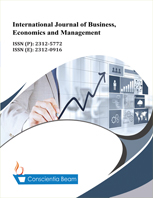The Relationship between Financial Development, Economic Growth, and Inflation: Evidence from Southeast Asia
DOI:
https://doi.org/10.18488/journal.62.2019.64.201.214Abstract
This study examines the relationship between financial development, economic growth, and inflation five developing Southeast Asian countries between 1997 and 2016 using a vector autoregressive model. The results revealed that: inflation positively affected money supply and stock market capitalization, but GDP per capita growth rate negatively; GDP per capita growth rate was positively correlated with domestic credit to the private sector; money supply positively affected stock market capitalization and inflation; domestic credit to the private sector exerted a positive influence on GDP per capita growth rate, but negative on inflation; and stock market capitalization was negatively related to inflation. Further, a directional relationship runs from GDP per capita to inflation, from inflation to money supply, and from inflation to domestic credit to the private sector. Policies are recommended to promote economic growth, reduce inflation, and achieve sustainable development in Southeast Asia. First, inflation should be carefully controlled as it causes a decline in the GDP per capita growth rate. Second, GDP per capita growth rate should be promoted owing to its positively effect on domestic credit to the private sector, which has been an important catalyst for economic growth in Southeast Asia over recent decades. Finally, domestic credit to the private sector and stock market capitalization should be fostered because of their contribution to reducing inflation and increasing the GDP per capita growth rate.

